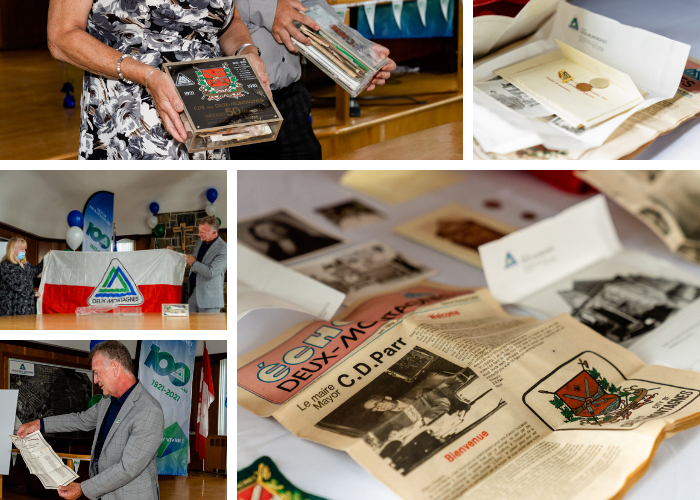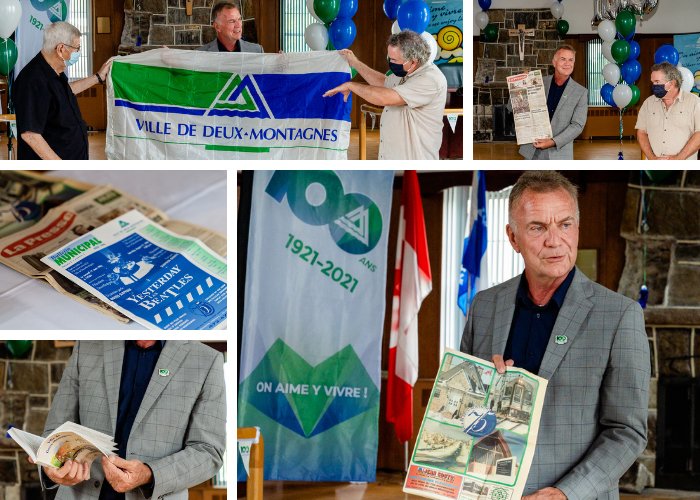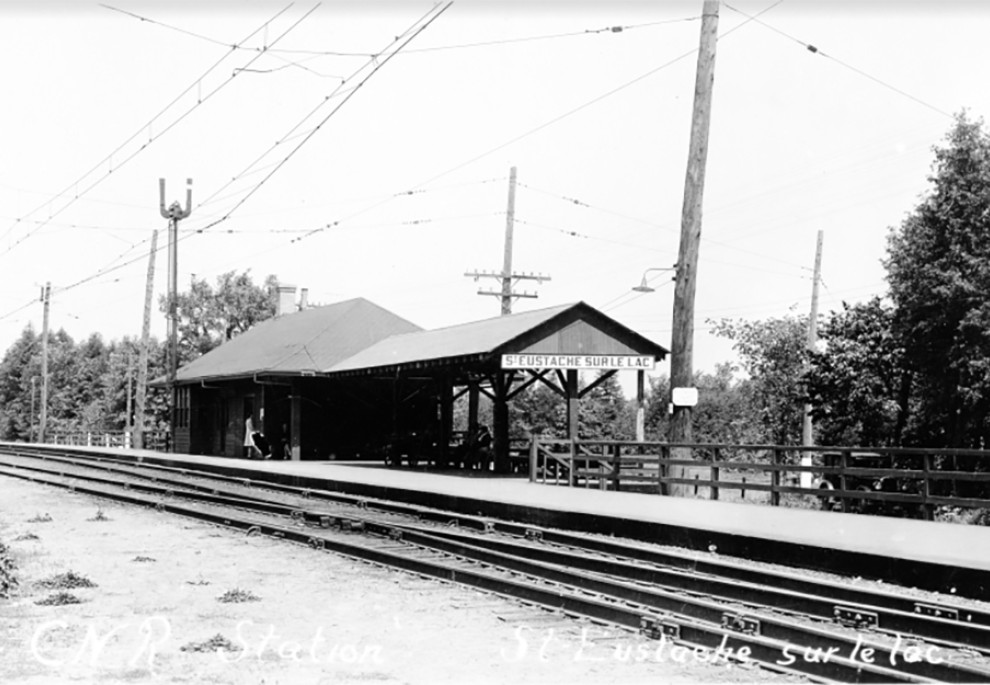Le 18 août 2021, à l’occasion du 100e anniversaire de la Ville, les membres du conseil municipal ont procédé à l’ouverture de deux capsules temporelles, enfouies sous une pierre du foyer de l’hôtel de ville en décembre 1981 puis en août 1996. Ce voyage dans le temps a été effectué en conférence de presse, au cours de laquelle le maire Denis Martin a également procédé à la fermeture de la capsule temporelle spécialement conçue pour le 100e.
Capsule temporelle de 1981 marquant le 50e anniversaire de l’hôtel de ville
La première capsule temporelle a été scellée le 4 décembre 1981 par M. Clifford D. Parr, maire de la Cité de Deux-Montagnes de 1974 à 1982, à l’occasion du 50e anniversaire de l’inauguration de l’hôtel de ville.
En ouvrant la boîte de plexiglas mesurant 8" par 8", le maire Martin a eu l’honneur de dévoiler plusieurs éléments témoignant de la composition du conseil municipal de 1978-1982 et de l’administration municipale de cette époque. On y retrouve notamment le budget (revenus et dépenses) de 1981 et un exemplaire du tout premier bulletin municipal, alors intitulé L’Écho Deux-Montagnes, imprimé sur papier journal et distribué aux portes en juin 1979. Est également insérés dans la capsule : des photos des élus municipaux et de gestionnaires en fonction, l’épinglette et le drapeau de la Ville, une broderie des armoiries et des pièces de monnaie de 1981.

1996 : de nouveaux éléments d’histoire s’ajoutent à la 1re capsule
Sous la pierre du foyer de l’hôtel de ville se trouvait enfouie une seconde capsule temporelle, bonifiant la première, créée pour souligner le 75e anniversaire de la Ville de Deux-Montagnes. L’ancien maire Pierre-Benoît Forget a eu le plaisir d’assister au dévoilement de son contenu, après l’avoir lui-même scellé il y a 25 ans. L’ancien conseiller municipal, Pierre Laparé, était également aux côtés du maire Denis Martin pour revenir sur certains pans de l’histoire de Deux-Montagnes, au fur et à mesure que des objets et documents étaient extraits de la capsule.
À l’instar de celle de 1981, cette capsule contient le drapeau et l’épinglette de la Ville, une deuxième épinglette à l’effigie du 75e et le bulletin municipal d’août 1996. En plus de ces éléments, y est inséré un cahier spécial 75e anniversaire publié dans le journal local La Concorde, édition du 21 février 1996. On y retrouve aussi le procès-verbal de la séance du conseil municipal du 8 août 1996, les éditions du 18 août 1996 des quotidiens La Presse et The Gazette, une carte routière du territoire deux-montagnais, ainsi qu’un exemplaire du livre « Ville de Deux-Montagnes 1804-1994 », écrit par Stéphane Plante.

2021 – La tradition se perpétue
En mars 2021, le coup d’envoi des festivités entourant le 100e anniversaire de la Ville a été donné par un appel à la population de Deux-Montagnes, incluant aux écoles, afin de recueillir les témoignages de citoyens pour les générations futures. Plusieurs collaborateurs des milieux scolaires ont d’ailleurs vu en ce projet un exercice d’écriture intéressant. L’objectif? Préserver les témoignages dans un tube en inox jusqu’à leur révélation au public lors des festivités du 200e de Deux-Montagnes.
Au terme d’un processus de sélection, 13 lettres de différentes catégories ont été retenues afin de léguer un échantillon significatif de la mémoire deux-montagnaise de 2021. Les plus jeunes étaient invités à imaginer Deux-Montagnes dans le futur, par lettre ou par dessin. D’autres étaient invités à se présenter, présenter leur école et à saluer les lecteurs du futur. Les citoyens pouvaient également y aller de leurs prédictions : à quoi ressemblera la ville dans 100 ans et comment aura évolué le monde?
« Les lecteurs du futur découvriront à quel point la pandémie de COVID-19 aura marqué la vie à notre époque, comme en témoignent quelques passages des lettres retenues. Ils constateront également à quel point l’environnement et l’enjeu du réchauffement climatique étaient au cœur des préoccupations des générations du passé », a souligné le maire Denis Martin tout en souhaitant que la situation ait évolué favorablement dans 100 ans.
En complémentarité à ces lettres de citoyens, des objets à l’effigie du 100e anniversaire ont été insérés dans la 3e capsule, de même que des publications distribuées en 2021 revenant sur l’histoire de la ville et sur les festivités du centenaire (calendrier municipal, bulletin L’Express, etc.). D’autres documents viennent quant à eux attester de la réalité financière de l’administration en place, comme le dépliant explicatif sur le compte de taxes, ou visent à donner une image fidèle de la Ville en 2021.
Rappelons que la capsule temporelle du 100e sera enfouie sur le site parc du Centenaire. Elle sera entretemps exposée à la bibliothèque.







